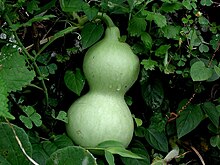

| Lagenaria | |
|---|---|

| |
| The calabash (L. siceraria) | |
| Scientific classification | |
| Kingdom: | Plantae |
| Clade: | Tracheophytes |
| Clade: | Angiosperms |
| Clade: | Eudicots |
| Clade: | Rosids |
| Order: | Cucurbitales |
| Family: | Cucurbitaceae |
| Subfamily: | Cucurbitoideae |
| Tribe: | Benincaseae |
| Genus: | Lagenaria Ser. |
| Synonyms | |
Lagenaria is a genus of gourd-bearing vines in the squash family (Cucurbitaceae). Lagenaria contains six species, all of which are indigenous to tropical Africa.[1] The best-known species, the calabash or bottle gourd, L. siceraria, has been domesticated by humans, and has spread beyond Africa. The other species are not cultivated.[1] The gourds of the various species may be harvested young and used as a vegetable. More commonly, the gourds are harvested mature, then dried, and used in making utensils (including musical instruments and containers). Gourds of L. siceraria have been used to store water and other liquids since ancient times. The generic name lagenaria comes from classical Latin lagena meaning bottle or flask, plus Latin suffix -aria.[2]

The genus comprises 6 species:
| Lagenaria |
|
|---|---|
| Authority control databases: National |
|
|---|
This Cucurbitales article is a stub. You can help Wikipedia by expanding it. |